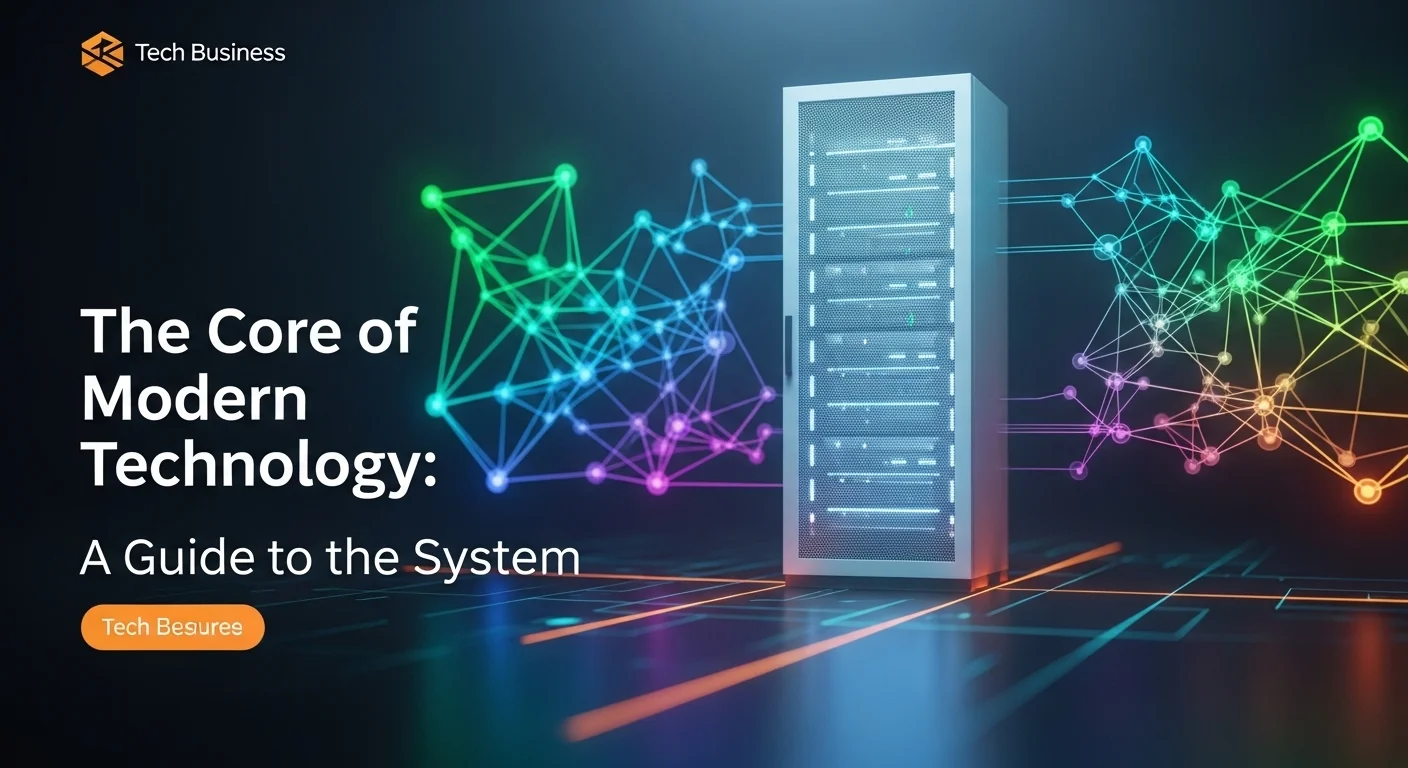What is a System in Technology? A Practical Guide for Everyone

Executive Summary
In all my years working in technology, I've found that the word 'system' is used everywhere, but not everyone gets what it truly means. At its heart, a system is simply a group of parts working together for a common purpose. This article is my attempt to pull back the curtain on this fundamental concept. We'll explore the operating systems that power your phone, the massive digital architectures that run global companies, and the crucial role of the system administrator—the professional who keeps it all running smoothly. We'll also look at essential tools like version control, which is a lifesaver for managing changes, and dive into some mind-blowing examples like the AI hardware from Cerebras Systems and NASA's incredible Space Launch System. My goal is to give you a clear, comprehensive understanding of how these systems are the real backbone of technological progress and business success.
Table of Contents
Table of Contents
What is a System and Why Does it Matter?
In the tech world, 'system' is a word we throw around a lot. But what does it actually mean? Think of it like a car's engine. It’s not just one thing; it's a collection of parts—pistons, spark plugs, belts—all designed to work together to make the car move. A technology system is the same idea. It’s a carefully organized mix of hardware (like servers), software (like apps), networks, and even human processes, all working in harmony to get something done. This simple concept is the foundation of our entire digital world. The apps on your phone, the internet, the complex operations of a global business—none of it would be possible without well-designed systems. For a business, a good system is what drives efficiency and opens the door to innovation. It could be an internal chat system that keeps your team in sync or a massive resource planning system that handles everything from inventory to payroll. These systems cut down on manual work, reduce errors, and provide data that helps you make smarter decisions. For anyone curious about tech, understanding systems is the key to seeing how the magic really happens.
The Unsung Heroes: Inside the Role of a System Administrator
So, who keeps all these complex systems running? That's where the system administrator, or 'sysadmin' as we often call them, comes in. I've worked alongside these folks for years, and they are the true guardians of a company's technology. They are responsible for installing, configuring, maintaining, and fixing the servers, networks, and software that form an organization's digital backbone. A sysadmin’s job is to make sure the entire digital environment is secure, always available, and running at peak performance. Their task list is huge and incredibly important: managing user accounts, running security checks, applying critical updates, and creating plans for what to do if things go wrong. In many ways, a sysadmin is the bridge between the complex technology and the people who use it every day, ensuring everything just works. Without a skilled administrator, even the most expensive system can fail, leading to downtime, security risks, and a massive loss of productivity. They are the behind-the-scenes heroes essential to any modern business.
A Safety Net for Change: The Power of Version Control
A game-changing tool for both software developers and any modern system administrator is the version control system (VCS). You've probably heard of Git, which is the most popular example. Originally, a VCS was created to help developers manage changes in code, but its usefulness has exploded. A version control system works like a time machine for files. It records every single change made, creating a detailed history of who changed what, and when. For a sysadmin, this is a lifesaver. As we've started defining our infrastructure—servers, networks, and all—as code files (a practice called Infrastructure as Code), a VCS has become indispensable for managing the whole environment. It lets an admin track changes to server configurations, easily roll back to a previous stable state if a new change causes problems, and work with other team members without stepping on each other's toes. This brings a level of order and safety to managing operations that used to be a messy, manual process. Using version control turns system management from a guessing game into a precise, controlled process.
Systems at the Extreme: AI Supercomputers and Deep Space Rockets
To see just how powerful systems can be, let's look at two very different but equally incredible examples: the hardware from Cerebras Systems and NASA's Space Launch System (SLS). Cerebras is a company that has built a computer system from the ground up specifically to accelerate artificial intelligence. Their main product is built around the Wafer-Scale Engine, the single largest computer chip ever made. This isn't your average computer; it's a highly specialized system designed to solve one massive problem: the huge computational power needed to train large AI models. It’s a perfect example of how system design is being pushed to new limits to unlock the future of technology.
On the other end of the scale is the Space Launch System, the massive rocket NASA designed to take humanity back to the Moon and beyond. The SLS isn't just one machine; it's a 'system of systems.' It's a mind-boggling integration of propulsion, electronics, software, life support, and ground control systems that all have to work together perfectly. It even reuses proven technology from the Space Shuttle program, like the powerful RS-25 engines, and blends it with new, state-of-the-art systems. The complexity is hard to comprehend, with millions of parts and lines of code all needing to be in perfect sync to ensure a safe and successful mission. The SLS is a stunning example of system engineering on a cosmic scale, showing that tackling humanity's biggest dreams relies on our ability to design and manage incredibly complex, integrated systems.

A Deeper Look: Systems in Business and Modern Tech
When you start digging into technology systems, you find a world of different designs, methods, and strategies that businesses use to get ahead. For any company today, understanding these principles isn't just a nice-to-have; it's critical for survival and growth. One of the first big decisions is architecture. Traditionally, many systems were 'monolithic'—built as a single, all-in-one unit. This was simple to start with, but as the system grew, it became a beast to manage, scale, and update. A problem in one small part could crash the whole thing. The modern approach is often 'microservices,' where the system is broken down into a collection of smaller, independent services. Each one handles a specific job and can be updated or scaled on its own. It offers incredible flexibility and resilience, which is why it's so popular for large applications. However, it’s not a magic bullet; managing this distributed system introduces its own challenges. Picking the right architecture is a huge business decision that really depends on your team, the complexity of what you're building, and your long-term goals.
The person navigating all this complexity is the system administrator. The job has changed so much over the years. Gone are the days of just racking servers in a cold room. Today's sysadmin needs to be a master of cloud platforms, virtualization, container tools like Docker and Kubernetes, and automation. I've seen firsthand how their main focus has shifted to guaranteeing reliability, performance, and security. This means being proactive—using monitoring tools to catch problems before users even notice them, setting up solid backup plans, and constantly protecting the system from cyberattacks. Automation has become their most powerful weapon. By using scripts and tools to automate repetitive jobs like setting up servers or deploying software, they save time and prevent human error. This frees them up to focus on the bigger picture, like optimizing performance and planning for future growth. The role is even blending with development in a movement called DevOps, where both teams work together to get things done faster and better.
In this new world, a version control system (VCS) like Git is the common language that brings everyone together. Developers use it for code, and the sysadmin uses it to manage infrastructure. By keeping configuration files in a VCS, they create a single source of truth. Every change is tracked, reviewed, and can be audited. If a change breaks something, you can hit the 'undo' button and go back to the last working version in seconds. This makes system management incredibly stable and predictable. I've seen teams of admins collaborate on complex network setups using branches in Git to work independently and then merge their changes safely, just like software developers do. It also provides a complete audit trail, which is a huge deal for security and meeting compliance regulations. Adopting a VCS for operations is a sign of a mature, modern IT team.
Looking at specialized systems gives us a glimpse into the future. Take Cerebras Systems, for example. They completely re-engineered the computer to be an AI powerhouse. Traditional systems often hit a 'memory wall'—the processor waits around for data to arrive from memory. Cerebras tackled this head-on by creating a single, massive chip that puts processing and memory right next to each other, making it incredibly fast for AI tasks. A company that invests in a Cerebras system is choosing a purpose-built tool that can train AI models in a fraction of the time. This highlights a huge trend: the shift towards specialized systems designed to do one high-value thing exceptionally well. As AI becomes more common in business, these specialized tools will be key to staying competitive.
Finally, there's the ultimate example of scale and complexity: the Space Launch System (SLS). As NASA's ride for the Artemis moon missions, it's one of the most complex projects ever attempted. It's a 'system of systems' where countless independent parts must work as one. You have the core stage with its four massive engines, two solid rocket boosters, the cryogenic upper stage, and the Orion capsule on top. Each is a huge system built by different teams. The real challenge is integration—making sure the physical, electrical, and software connections between all these pieces are flawless. The flight software alone has millions of lines of code that have to run perfectly. The management of this project teaches an essential lesson for any large business project: success isn't just about the quality of the parts, but about the disciplined engineering that connects them. It’s a powerful reminder of what humans can achieve with systematic design and a relentless focus on reliability.

Practical Tips and Strategies for Mastering Technology Systems
Knowing the theory is one thing, but to really get the most out of technology systems, you need practical strategies. Whether you're a business owner trying to make smart IT choices or a tech pro looking to sharpen your skills, here’s what I’ve learned works best. First and foremost, embrace automation. So many IT tasks are repetitive and time-consuming—backups, patching, creating user accounts. Doing these by hand is slow and invites mistakes. A savvy system administrator uses automation tools to handle this work. You can start with simple scripts or go all-in with platforms like Ansible or Puppet. By automating the routine stuff, the sysadmin can focus on what really matters: improving performance, strengthening security, and planning for the future. My advice? Start small. Find one manual task that drives you crazy and automate it. That small win will build momentum for a bigger shift.
Using a version control system (VCS) effectively is another non-negotiable for modern system management. To make the most of a tool like Git for your infrastructure, follow a few best practices. First, commit your changes often and write clear, simple messages explaining what you did. This creates a history that's easy to follow. Second, use branches for everything. Never work directly on your main 'production' branch. Create a separate branch for your changes, test them, and then merge them in, ideally after a teammate has reviewed them. This simple workflow prevents bad changes from taking down your live environment. Third, make your VCS repository the one and only source of truth. No more logging into servers to make 'quick fixes.' All changes must go through version control. This discipline makes your infrastructure stable, documented, and reproducible.
You can learn a lot from looking at the extremes. Think about Cerebras Systems, building those incredibly fast AI computers. Most of us don't need an AI supercomputer, but the lesson from their success applies to everyone: find the biggest bottleneck in your system and focus your energy on solving it. For Cerebras, the bottleneck was the time it took to move data. For your business, it might be slow database queries or an inefficient app. The strategy is to use monitoring tools to find the exact pain point and then apply a specific fix. The takeaway from Cerebras is to think systematically about performance and not be afraid to find creative solutions.
Similarly, the Space Launch System (SLS) teaches powerful lessons about reliability. As the world's most powerful rocket, its design is all about safety and success. NASA achieves this with extreme redundancy (backups for critical systems) and brutal testing. Every single component is tested for thousands of hours to simulate the violent environment of a launch. For businesses where system failure is not an option—like finance or healthcare—the SLS is a masterclass in building resilient systems. The lesson is to invest in redundancy for your critical components, have a thorough testing plan that includes 'what-if' failure scenarios, and keep detailed documentation for everything. The scale is different, but the principles of building for reliability are universal, whether you're launching a rocket or an e-commerce site.
Finally, never stop learning. This field changes at lightning speed. A system administrator who stops learning becomes obsolete. You have to be proactive. Read tech blogs, join online communities, watch webinars, and experiment with new tools in a safe environment, like a home lab or a cloud sandbox. In my experience, the most successful people in this field are endlessly curious and committed to learning. By adopting these strategies—automating everything you can, mastering version control, learning from extreme examples like Cerebras Systems and the Space Launch System, and never stopping your education—you'll not only improve your tech experience but set yourself up for success for years to come.
Expert Reviews & Testimonials
Sarah Johnson, Business Owner ⭐⭐⭐
This was a good overview of tech systems, but as a small business owner, I'd love to see more specific examples for companies my size.
Mike Chen, IT Consultant ⭐⭐⭐⭐
Really solid article on Systems. It clarified a lot of concepts for me and my team. A few parts were a little technical, but overall very helpful.
Emma Davis, Tech Expert ⭐⭐⭐⭐⭐
Fantastic piece! This is one of the most comprehensive yet easy-to-understand articles on Systems I've read. It connected all the dots for me. Excellent work!



